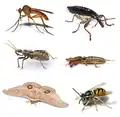List of insect orders

Insecta is a class of invertebrates that consists of around 30 individual orders.[1] Orders are the fifth taxonomic rank used to classify living organisms, below the rank of class, but above the rank of family.[2] With around 1 million insect species having been formally described and assigned a binomial name, insects are the most diverse group of animals, comprising approximately half of extant species on Earth. The total insect biodiversity has been estimated at around 6 million species.[3][4] The most diverse orders are Coleoptera (beetles), Hymenoptera (wasps, bees, ants and sawflies), Lepidoptera (butterflies and moths), Diptera (flies) and Hemiptera (true bugs).[5] Taxonomists disagree on the exact number of orders, with opinions ranging from 26 to 32 distinct extant orders.[6]
Insecta was originally divided into seven orders in 1758 by Carl Linnaeus in the 10th edition of Systema Naturae. When Insecta was originally described it was split into two informal groups, Paleoptera and Neoptera.[7] Insects that do not have the ability to fold their wings over their abdomen were sorted into Paleoptera, and ones that could (or had an ancestor that could) were sorted into Neoptera.[7] Individual orders were primarily defined by the number and structure of wings, with other factors such as antennae being considered.[8] The classification of insects changes as new discoveries are found, with species regularly shifted around different orders.[9] The most recent order described was the monotypic (an order with only one family) Mantophasmatodea in 2002.[9]
Apterygota
Apterygota is a paraphyletic (a grouping that consists of the grouping's last common ancestor and some but not all of its descendant lineages) group containing two orders of primitive and wingless insects, historically united on the basis of morphology.[10]
| Order[a] | Common name(s) | Description | Number of species[b] | Image |
|---|---|---|---|---|
| Archaeognatha Börner, 1904 |
Jumping bristletails | The Archaeognatha are the most evolutionarily primitive taxa (remaining mostly unchanged since their most recent common ancestor) in insects.[12] Species are characterized by their elongated bodies and retractable mouthparts. They have an arched thorax and a small head.[12] Bodies are cylindrical and do not have any scales.[13] They are distributed globally and prefer woodland areas.[13] Their tails consist of three long structures and can use them to jump up to 12 inches.[14] | 500[11] | 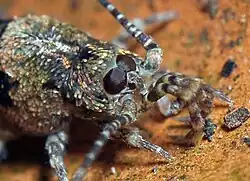 |
| Zygentoma Börner, 1904 |
Silverfish and firebrats | Species of Zygentoma are usually flat with two lengthy cerci (primitive sensory organs that can detect light).[15] The most widely distributed species is the silverfish (Lepisma saccharinum).[16] The thoraxes are wide, and the surface is covered in small dry scales.[17] Most live under bark or litter structures.[17] They are most common in humid environments, but some species have developed to withstand higher temperatures.[17] | 600[11] | .jpg) |
Palaeoptera
Palaeoptera is an infraclass (the taxonomic rank directly below subclass) of insects with 2 existing orders.[18] Wings of Palaeoptera cannot be folded back when they are not being used, and species undergo hemimetaboly (metamorphosis missing one or more stages rather than complete metamorphosis).[19]
| Order | Common name(s) | Description | Number of species | Image |
|---|---|---|---|---|
| Ephemeroptera Hyatt & Arms, 1890 |
Mayflies | Ephemeroptera are small aquatic insects found primarily in North America.[20] Females lay their eggs in water and do not feed during the adult stage. They spend almost their entire lives as larvae (sometimes up to a year), before growing into adults and living for one or two days.[20] | 3,100[11] |  |
| Odonata Fabricius, 1793 |
Dragonflies and damselflies | Odonata consists primarily of dragonflies and damselflies. They are large, narrow insects characterised by clear wings and a long abdomen.[21] Species are brightly colored and up to four inches in length. They are aquatic and lay their eggs in or around bodies of water.[21] | 6,000[11] | _male_Bulgaria_(cropped).jpg) |
Polyneoptera
Polyneoptera is a group of winged insects that possess four wings, long antennae and mouths specialized for chewing.[22][c] When stationary, their wings are typically folded over their body flat.[23] They are hemimetabolous, hatching as nymphs which gradually acquire their adult morphology through successive moults.[24]
| Order | Common name(s) | Description | Number of species | Image |
|---|---|---|---|---|
| Blattodea Wattenwyl, 1882 |
Cockroaches and termites | Blattodea is an order that contains cockroaches and termites.[25] They have oval bodies and short cerci (appendages situated on the rear). They are most common in tropical climates and can live as pests in human structures.[26] | 8,600[11] | 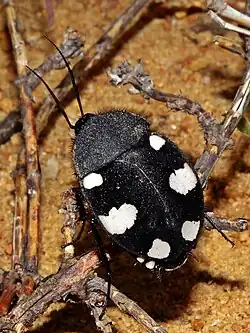 |
| Dermaptera De Geer, 1773 |
Earwigs | Dermaptera are slender insects are slender with beaded antennae, a segmented body and pincer-like cerci.[27] | 2,000[11] | 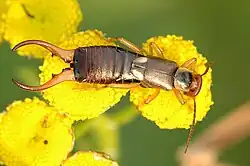 |
| Embioptera Lameere, 1900 |
Webspinners | Embioptera is an order of small insects with long, cylindrical bodies.[28] They have short legs and two cerci. Some males have two pairs of wings, and females have none.[28] | 500[11] | 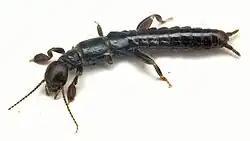 Notoligotoma nitens
|
| Grylloblattodea Brues & Melander, 1932 |
Ice crawlers | Grylloblattodea is a rare group of insects found in Asia and North America.[29] Their bodies are adapted to survive in cold and mountain climates.[30] Grylloblattodea is sometimes ranked as a suborder of the order Notoptera, alongside Mantophasmatodea.[31] | 500[11] | 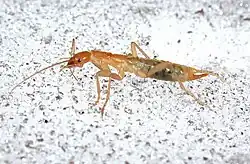 Grylloblatta sp.
|
| Mantodea Burmeister, 1838 |
Mantises (or praying mantises) | Mantodea is an order of insects that usually prey on other insects.[32] They exhibit a diverse range of colors and shapes, and are distributed worldwide.[32] | 2,400[11] | .jpg) |
| Mantophasmatodea Zompro et al., 2002 |
Gladiators or heelwalkers | Mantophasmatodea is a monotypic order of wingless insects. It is the smallest insect order and was first described in 2002.[33] They are found exclusively in Southwest Africa. They have cylindrical bodies and tarsi segmented into five parts.[33] Mantophasmatodea is sometimes ranked as a suborder of Notoptera, alongside Grylloblattodea.[31] | 23[11] |  |
| Orthoptera Latreille, 1793 |
Grasshoppers, crickets, and locusts | Orthoptera is an order of insects that consists of crickets, grasshoppers, and locusts.[34] Most individuals live for around one year and undergo simple metamorphosis with three stages.[34] | 24,500[11] | _male.jpg) |
| Phasmatodea Jacobson & Bianchi, 1902 |
Stick insects and leaf insects | Phasmatodea is an order of large and slim insects, originating in the Australasian region.[35] Species have evolved their bodies to camouflage themselves among leaves and twigs.[35] They are dorso-ventrally flattened, and primarily concetrated in Asia and Australasia.[35] | 3,100[11] | |
| Plecoptera Burmeister, 1839 |
Stoneflies | Plecoptera is a small order of insects that is distributed globally.[36] It is most common in temperate climates. Species usually have small ocelli and dorso-ventrally flattened bodies.[37] | 3,800[11] | 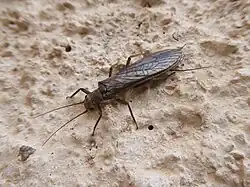 Perla sp.
|
| Zoraptera Silvestri, 1913 |
Angel insects | Zoraptera is a small order primarily found in tropical regions.[38] Species are usually four millimeters or less and have two forms: dark, winged alates, with both eyes and ocelli, and pale, wingless, blind individuals.[39] | 45[11] |  |
Paraneoptera
Paraneoptera is a superorder of insects that undergo hemimetaboly.[40] Many species are agricultural pests, damaging the plants that they feed on.[41] The lifespan of species in Paraneoptera are short, with some lasting 6 weeks or less.[42]
| Order | Common name(s) | Description | Number of species | Image |
|---|---|---|---|---|
| Hemiptera Linnaeus, 1758 |
True bugs | Hemiptera have piercing mouthparts that are used to suck from their food, with species exhibiting a cone or beak shaped structure.[43] | 104,200[11] | 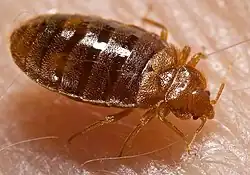 |
| Psocodea Hennig, 1966 |
Barklice, booklice, and parasitic lice | Psocodea is a group of small insects with soft bodies.[44] It consists primarily of lice, and species are dorso-ventrally flattened across their bodies.[44] | 5,700[11] | _Columbicola_columbae_(Mallophaga).jpg) |
| Thysanoptera Haliday, 1836 |
Thrips | Thysanoptera are small winged insects that feed on plants.[45] They are usually no more than two millimeters in length and are attracted to bright colors.[45] | 6,100[11] |  |
Holometabola
Holometabola is a group of insects that are characterized by complete metamorphosis (insects that go through egg, larva, pupa and adult stages).[46] The orders Coleoptera, Hymenoptera, Diptera and Lepidoptera contain the greatest number of species in this group (more than 99%).[46]
| Order | Common name(s) | Description | Number of species | Image |
|---|---|---|---|---|
| Coleoptera Linnaeus, 1758 |
Beetles | Coleoptera is the largest order of insects, and contains a fourth of all extant animals.[47] Species have three parts (a head, thorax, and abdomen) and a set of compound eyes. Most species can fly, while some species in desert regions have lost the ability.[47] | 392,400[11] | 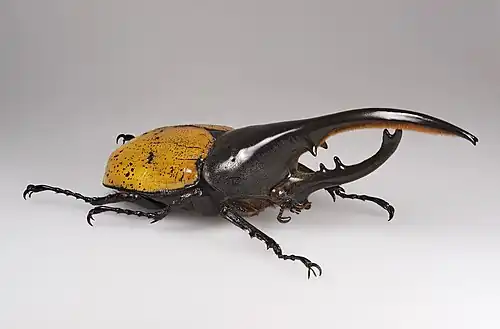 |
| Diptera Linnaeus, 1758 |
Flies | Diptera is a large, globally distributed order of insects.[48] Species have one set of wings[d] and a pair of organs called halteres to help with balance.[49] | 160,600[11] | 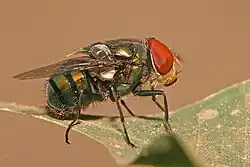 |
| Hymenoptera Linnaeus, 1758 |
Bees, wasps, ants and sawflies | Hymenoptera is a large order of insects that primarily consists of bees, wasps, and ants.[50] 6,000 to 7,000 new species are described each year. Hymenoptera play a significant role in plant pollination and the development of crops.[50] | 155,500[11] | 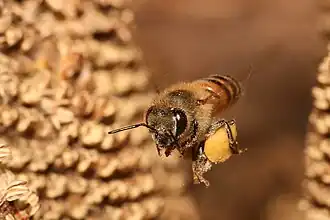 |
| Lepidoptera Linnaeus, 1758 |
Butterflies and moths | Lepidoptera consists of butterflies and moths.[51] They exist on all continents except Antarctica and have a diverse range of colors and sizes.[51] | 158,600[11] | _2.jpg) |
| Mecoptera Packard, 1886 |
Scorpionflies | Mecoptera is an order of insects primarily distributed in Australasian and Neotropical areas.[52] They range in length from two millimeters to 35 millimeters. The families Panorpidae and Bitticidae contain the majority of extant species.[52] Some phylogenies recover Siphonaptera as part of an otherwise paraphyletic Mecoptera. In that case, Siphonaptera may be assigned a lower rank within the order Mecoptera,[53] or the mecopteran families Nannochoristidae and Boreidae may be regarded as the separate orders Nannomecoptera and Neomecoptera.[54] | 800[11] | .jpg) |
| Megaloptera Latreille, 1802 |
Alderflies, dobsonflies, fishflies | Megaloptera is a small order of insects commonly found in aquatic areas. The adults have long, segmented antennae and are usually winged.[55] Species undergo all four stages of metamorphosis during development.[55] | 400[11] | 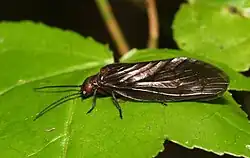 Protosialis americana
|
| Neuroptera Linnaeus, 1758 |
Lacewings | Neuroptera is an order of insects distributed globally. They have two pairs of wings and long antennae.[56] | 5,900[11] | 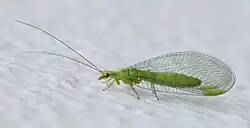 Chrysopa formosa
|
| Raphidioptera Handlirsch, 1908 |
Snakeflies | Raphidioptera is an order of predatory insects with elongated prothoraxes. Some taxonomists have grouped Raphidioptera together with the related Megaloptera.[57] | 300[11] | 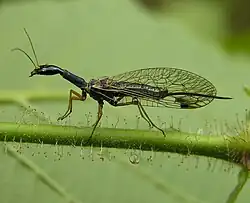 |
| Siphonaptera Latreille, 1825 |
Fleas | Siphonaptera is an order of blood-sucking insects that are globally distributed. They are most prevalent in temperate climates.[58] Siphonaptera primarily feed on mammals, although some species feed on birds as well.[59] | 2,100[11] | 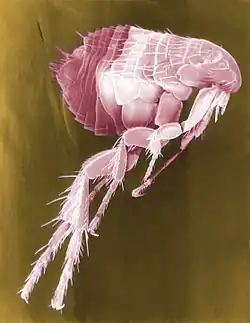
|
| Strepsiptera Kirby, 1813 |
Twisted-wing parasites | Strepsiptera is an order of small obligate endoparasites divided into 12 families (10 extant and two extinct).[60] The males range in length from one millimeter (0.039 in) to seven millimeters (0.28 in). The females range in length from two millimeters (0.079 in) to 30 millimetres (1.2 in).[60] In Stylopidia, which comprises the vast majority of species, females are permanent endoparasites and possess reduced legs, antennae, and eyes.[61] | 600[11] | 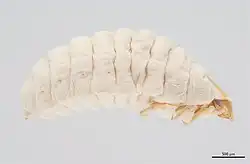 Mengenilla moldrzyki |
| Trichoptera Kirby, 1813 |
Caddisflies | Trichoptera is an order of insects found in freshwater areas.[62] | 15,200[11] | 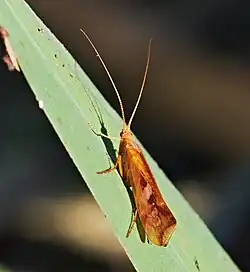 |
Notes
- ^ The author citation (last name and year of the person(s) who originally described the order) is listed under the order name.
- ^ The exact number of species changes as new ones are described; the figures described are based on a 2013 report by Zhi-Qiang Zhang, and orders with more than 100 species are rounded to the nearest hundred.[11]
- ^ Some species in Phasmatodea, Dermaptera and Zoraptera are secondarily wingless having lost their wings during evolution.[22]
- ^ Some parasitic species in alpine regions have lost their wings through evolution.[49]
References
- ^ "Guide to Insect and Non-Insect Arthropods" (PDF). AgriLIFE Extension - Texas A&M System. 2018. Archived (PDF) from the original on 2024-07-13. Retrieved 2025-06-15.
- ^ Rawat 2023, p. 14
- ^ Stork, Nigel E. (2018-01-07). "How Many Species of Insects and Other Terrestrial Arthropods Are There on Earth?". Annual Review of Entomology. 63 (63): 31–45. doi:10.1146/annurev-ento-020117-043348. ISSN 0066-4170. PMID 28938083. Archived from the original on 2025-06-15. Retrieved 2025-06-15.
- ^ Li, Xin; Wiens, John J (2023-06-16). Bond, Jason (ed.). "Estimating Global Biodiversity: The Role of Cryptic Insect Species". Systematic Biology. 72 (2): 391–403. doi:10.1093/sysbio/syac069. ISSN 1063-5157. PMID 36301156.
- ^ "Insect taxonomy". Science Learning Hub. 2019-11-11. Archived from the original on 2025-06-15. Retrieved 2025-06-15.
- ^ Rivers 2017, p. 179
- ^ a b Abbott & Abbott 2023, p. 11
- ^ Engel, Michael S.; Kristensen, Niels P. (2013-01-07). "A History of Entomological Classification". Annual Review of Entomology. 58 (58): 585–607. doi:10.1146/annurev-ento-120811-153536. ISSN 0066-4170. PMID 23317047. Archived from the original on 2024-10-13. Retrieved 2025-06-16.
- ^ a b Ring & Resh 2003, p. 565
- ^ Trautwein, Michelle D.; Wiegmann, Brian M.; Beutel, Rolf; Kjer, Karl M.; Yeates, David K. (2012-01-07). "Advances in Insect Phylogeny at the Dawn of the Postgenomic Era". Annual Review of Entomology. 57 (1): 449–468. doi:10.1146/annurev-ento-120710-100538. ISSN 0066-4170. PMID 22149269. Archived from the original on 2022-05-17. Retrieved 2025-06-20.
- ^ a b c d e f g h i j k l m n o p q r s t u v w x y z aa ab ac Zhang, Zhi-Qiang (2013-08-30). "Phylum Arthropoda. In: Zhang, Z.-Q. (Ed.) Animal Biodiversity: An Outline of Higher-level Classification and Survey of Taxonomic Richness (Addenda 2013)". Zootaxa. 3703 (1): 17–26. doi:10.11646/zootaxa.3703.1.6. ISSN 1175-5334.
- ^ a b "Jumping Bristletails". Encyclopedia of Arkansas. 2022-09-01. Archived from the original on 2025-01-19. Retrieved 2025-06-16.
- ^ a b "Order Archeognatha – ENT 425 – General Entomology". NC State Agricultural and Life Sciences. Archived from the original on 2025-05-18. Retrieved 2025-06-16.
- ^ "[Occasional Invaders] A New Look at an Old Group". Pest Control Technology. 2011-05-27. Archived from the original on 2025-06-17. Retrieved 2025-06-16.
- ^ "Order Zygentoma – ENT 425 – General Entomology". NC State Agriculture and Life Sciences. Archived from the original on 2025-05-14. Retrieved 2025-06-16.
- ^ Molero-Baltanás, Rafael; Mitchell, Andrew; Gaju-Ricart, Miquel; Robla, Jairo (2024-05-01). "Worldwide revision of synanthropic silverfish (Insecta: Zygentoma: Lepismatidae) combining morphological and molecular data". Journal of Insect Science (Online). 24 (3): 1. doi:10.1093/jisesa/ieae045. ISSN 1536-2442. PMC 11069193. PMID 38703100.
- ^ a b c "Børstehaler". Artsdatabanken (in Norwegian Bokmål). 2014-03-22. Archived from the original on 2020-03-29. Retrieved 2025-06-16.
- ^ "Paleoptera - (General Biology I) - Vocab, Definition, Explanations | Fiveable". Fiveable. Archived from the original on 2025-06-18. Retrieved 2025-06-16.
- ^ Gillott, Cedric (1980). Gillott, Cedric (ed.). "Paleoptera". Entomology. Boston, MA: Springer US. pp. 121–136. doi:10.1007/978-1-4615-6915-2_6. ISBN 978-1-4615-6915-2. Retrieved 2025-06-16.
- ^ a b "Mayflies | National Wildlife Federation". National Wildlife Federation. Archived from the original on 2025-04-27. Retrieved 2025-06-16.
- ^ a b "Odonata | Dragonflies & Damselflies, Aquatic Insects | Britannica". Britannica. Archived from the original on 2025-03-18. Retrieved 2025-06-16.
- ^ a b "Orthopteroids – ENT 425 – General Entomology". NC State Agricultural and Life Sciences. Retrieved 2025-06-16.
- ^ Taylor, Christopher (2014-12-01). "Polyneoptera". Archived from the original on 2025-05-13. Retrieved 2025-06-16.
- ^ Belles, Xavier (2011). "Origin and Evolution of Insect Metamorphosis". Encyclopedia of Life Sciences. John Wiley & Sons, Ltd. doi:10.1002/9780470015902.a0022854. ISBN 978-0-470-01590-2. Archived from the original on 2021-03-08. Retrieved 2025-06-18.
- ^ "ITIS - Report: Blattodea". Integrated Taxonomic Information System. Archived from the original on 2022-02-21. Retrieved 2025-06-16.
- ^ "Order Blattodea – ENT 425 – General Entomology". Archived from the original on 2023-11-28. Retrieved 2025-06-16.
- ^ "Order Dermaptera – ENT 425 – General Entomology". NC State Agriculture and Life Sciences. Archived from the original on 2025-02-13. Retrieved 2025-06-16.
- ^ a b "Embioptera - webspinners". Commonwealth Scientific and Industrial Research Organisation. Archived from the original on 2025-03-13. Retrieved 2025-06-23.
- ^ Jarvis, Karl J.; Whiting, Michael F. (2006). "Phylogeny and biogeography of ice crawlers (Insecta: Grylloblattodea) based on six molecular loci: designating conservation status for Grylloblattodea species". Molecular Phylogenetics and Evolution. 41 (1): 222–237. Bibcode:2006MolPE..41..222J. doi:10.1016/j.ympev.2006.04.013. ISSN 1055-7903. PMID 16798019.
- ^ Schoville, Sean D.; Roderick, George K. (2010-06-02). "Evolutionary diversification of cryophilic Grylloblattaspecies (Grylloblattodea: Grylloblattidae) in alpine habitats of California". BMC Evolutionary Biology. 10 (1): 163. Bibcode:2010BMCEE..10..163S. doi:10.1186/1471-2148-10-163. ISSN 1471-2148. PMC 2898686. PMID 20525203.
- ^ a b Arillo, A.; Engel, M.S. (2006). "Rock crawlers in Baltic amber (Notoptera: Mantophasmatodea)". American Museum Novitates (3539): 1–10. doi:10.1206/0003-0082(2006)3539[1:RCIBAN]2.0.CO;2. Archived from the original on 2023-11-06. Retrieved 2025-06-18.
- ^ a b "Marvellous Mantodea". University of Oxford. 2018-01-01. Archived from the original on 2025-06-18. Retrieved 2025-06-17.
- ^ a b "Order Mantophasmatodea - ENT 425 - General Entymology". NC State Agriculture and Life Sciences. Archived from the original on 2025-02-13. Retrieved 2025-06-18.
- ^ a b Gurney, Ashley (1999-07-26). "Orthoptera | Description, Insect Order, Grasshopper, Cricket, Katydid". Britannica. Archived from the original on 2025-06-10. Retrieved 2025-06-18.
- ^ a b c Bank, Sarah; Cumming, Royce; et al. (2021-08-02). "A tree of leaves: Phylogeny and historical biogeography of the leaf insects (Phasmatodea: Phylliidae)". Communications Biology. 4 (1): 932. doi:10.1038/s42003-021-02436-z. ISSN 2399-3642. PMC 8329230. PMID 34341467.
- ^ Lillehammer 1988, p. 7
- ^ Lillehammer 1988, p. 10
- ^ Matsamura, Yoko; Beutal, Rolf; et al. (2019-11-21). "The evolution of Zoraptera". Systematic Entomology. 45 (2). Wiley: 349–364. doi:10.1111/syen.12400. hdl:2115/76853. ISSN 1365-3113 – via Royal Entomological Society.
- ^ "Order Zoraptera - ENT 425 - General Entymology". NC State Agriculture and Life Sciences. Archived from the original on 2025-02-13. Retrieved 2025-06-18.
- ^ Dacks, Andrew M.; Christensen, Thomas A.; Hildebrand, John G. (2006-10-20). "Phylogeny of a serotonin‐immunoreactive neuron in the primary olfactory center of the insect brain". Journal of Comparative Neurology. 498 (6): 727–746. doi:10.1002/cne.21076. ISSN 0021-9967.
- ^ "1KITE Database -1,000 Insect Transcriptome Evolution". 1KITE. Archived from the original on 2025-06-18. Retrieved 2025-06-16.
- ^ Panizzi & Parra 2012, p. 106
- ^ "Order Hemiptera". Macroinvertabrates.org. Archived from the original on 2025-01-20. Retrieved 2025-06-17.
- ^ a b Poirier, Lisa. "Psocodea – Lice". Pressbooks.
- ^ a b "Biology and Management of Thrips Affecting the Production Nursery and Landscape". University of Georgia Extension. Archived from the original on 2025-04-15. Retrieved 2025-06-17.
- ^ a b "Phylogeny of Holometabolous Insect Orders". Brigham Young University. 2021-05-04. Archived from the original on 2025-04-19. Retrieved 2025-06-16.
- ^ a b "Beetle | Sand Diego Zoo Animals & Plants". San Diego Wildlife Alliance. Archived from the original on 2025-04-28. Retrieved 2025-06-19.
- ^ "Order Diptera - ENT 424 - General Entymology". NC State Agriculture and Life Sciences. Archived from the original on 2025-02-13. Retrieved 2025-06-19.
- ^ a b "True Flies (Diptera)". Smithsonian Institution. Archived from the original on 2025-04-21. Retrieved 2025-06-19.
- ^ a b "Wasps, Ants, and Bees (Hymenoptera)". Smithsonian Institution. Archived from the original on 2025-05-10. Retrieved 2025-06-19.
- ^ a b Culin, Joseph (1999-07-26). "Lepidoptera | Definition, Butterfly, Moth, Skipper, Characteristics, Life Cycle". Britannica. Archived from the original on 2025-04-20. Retrieved 2025-06-19.
- ^ a b Capinera 2008, p. 3304
- ^ Tihelka, Erik; Giacomelli, Mattia; Huang, Di-Ying; Pisani, Davide; Donoghue, Philip C. J.; Cai, Chen-Yang (2020). "Fleas are parasitic scorpionflies". Palaeoentomology. 3 (6): 641–653. doi:10.11646/palaeoentomology.3.6.16. hdl:1983/8d3c12c6-529c-4754-b59d-3abf88a32fc9. ISSN 2624-2834.
- ^ Whiting, Michael F. (2004). "Phylogeny of the Holometabolous Insects". In Cracraft, Joel; Donoghue, Michael J. (eds.). Assembling the Tree of Life. Oxford University Press. p. 355. ISBN 978-0-19-972960-9.
- ^ a b "Megaloptera - ENT 425 - General Entymology". NC State Agriculture and Life Sciences. Archived from the original on 2025-02-13. Retrieved 2025-06-19.
- ^ "Neuroptera - Lacewings | Wildlife Journal Junior". New Hampshire PBS. Archived from the original on 2025-06-15. Retrieved 2025-06-15.
- ^ Barnard 1999, p. 79
- ^ "Order Siphonaptera - ENT 425 - General Entymology". NC State Agriculture and Life Sciences. Archived from the original on 2025-02-13. Retrieved 2025-06-19.
- ^ Ring & Resh 2003, p. 926
- ^ a b Ring & Resh 2003, p. 971
- ^ Pohl, Hans; Beutel, Rolf Georg (2008). "The evolution of Strepsiptera (Hexapoda)". Zoology. 111 (4): 327. doi:10.1016/j.zool.2007.06.008.
- ^ Malm, Tobias; Johanson, Kjell Arne; Wahlberg, Niklas (2012). "The evolutionary history of Trichoptera (Insecta): A case of successful adaptation to life in freshwater". Systematic Entomology. 38 (3): 459–473. doi:10.1111/syen.12016. ISSN 0307-6970.
Bibliography
- Rivers, David (2017). Insects : evolutionary success, unrivaled diversity, and world domination. Baltimore: Johns Hopkins University Press. ISBN 9781421421704. OCLC 948805339.
- Rawat, Vineeta (2023). Animal Taxonomy, Behaviour and Chronobiology. Info Capsule. ISBN 9788196080655.
- Gullan, Penny; Cranston, Peter (2010). The insects : an outline of entomology (4th ed.). Wiley-Blackwell. ISBN 9781444330366. OCLC 428436711.
- Panizzi, Antônio; Parra, José (2012). Insect bioecology and nutrition for integrated pest management. CRC Press. ISBN 9781439837085. OCLC 475450703.
- Ring, Carde; Resh, Vincent (April 4, 2003). Encyclopedia of Insects. Academic Press. ISBN 9780080546056.
- Lillehammer, Albert (1988). Stoneflies (Plecoptera) of Fennoscandia and Denmark. Leiden: Brill Academic Publishers. ISBN 9789004086951. OCLC 17547285.
- Capinera, John (2008). Encyclopedia of entomology. Springer Science+Business Media. ISBN 9781402063602. OCLC 288440300.
- Barnard, Peter (1999). Identifying British insects and arachnids : an annotated bibliography of key works. Cambridge University Press. ISBN 9780521632416. OCLC 39464902.
- Abbott, John; Abbott, Kendra (2023). Insects of North America. Princeton: Princeton University Press. ISBN 9780691232867. OCLC 1369650272.

